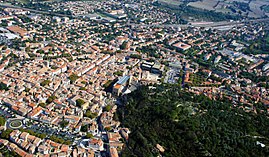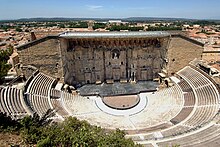Orange, Vaucluse
Orange
Aurenja (Occitan) | |
|---|---|
 Aerial view of central Orange | |
| Coordinates: 44°08′18″N 4°48′35″E / 44.1383°N 4.8097°E | |
| Country | France |
| Region | Provence-Alpes-Côte d'Azur |
| Department | Vaucluse |
| Arrondissement | Carpentras |
| Canton | Orange |
| Intercommunality | Pays Réuni d'Orange |
| Government | |
| • Mayor (2021–2026) | Yann Bompard[1] (LS) |
| Area 1 | 74.2 km2 (28.6 sq mi) |
| Population (2021)[2] | 28,949 |
| • Density | 390/km2 (1,000/sq mi) |
| Time zone | UTC+01:00 (CET) |
| • Summer (DST) | UTC+02:00 (CEST) |
| INSEE/Postal code | 84087 /84100 |
| Elevation | 24–127 m (79–417 ft) (avg. 50 m or 160 ft) |
| 1 French Land Register data, which excludes lakes, ponds, glaciers > 1 km2 (0.386 sq mi or 247 acres) and river estuaries. | |
| UNESCO World Heritage Site | |
|---|---|
 | |
| Includes | Roman Theatre of Orange and Triumphal Arch of Orange |
| Criteria | Cultural: iii, vi |
| Reference | 163 |
| Inscription | 1981 (5th Session) |
Orange (French pronunciation: [ɔʁɑ̃ʒ]; Provençal: Aurenja (classical norm) or Aurenjo (Mistralian norm)) is a commune in the Vaucluse department in the Provence-Alpes-Côte d'Azur region in Southeastern France. It is about 21 km (13 mi) north of Avignon, on the departmental border with Gard, which follows the Rhône and also constitutes the regional border with Occitania. Orange is the second-most populated city in Vaucluse, after Avignon.
Name
The settlement is attested as Arausio and Arausion in the first and second centuries AD, then as civitas Arausione in the fourth century, civitas Arausicae in 517 (via a Germanized form *Arausinga), Aurengia civitatis in 1136, and as Orenga in 1205.[3][4]
The name Arausio can be explained as the
History
Roman Orange was founded in 35 BC by veterans of the
A previous Celtic settlement with that name existed in the same place; a major battle, which is generally known as the
Arausio covered an area of some 70 ha (170 acres) and was well-endowed with civic monuments; in addition to the theatre and arch, it had a monumental temple complex and a forum.
-
Orange in the Table Peutinger
-
Romancadasterof Orange
-
The Roman Theatre in Orange
It was the capital of a wide area of northern Provence, which was parcelled up into lots for the Roman colonists. "Orange of two thousand years ago was a miniature Rome, complete with many of the public buildings that would have been familiar to a citizen of the Roman Empire, except that the scale of the buildings had been reduced – a smaller theater to accommodate a smaller population, for example."[7] It is found in both the Tabula Peutingeriana and Le cadastre d'Orange maps.
The town prospered, but was sacked by the
The sovereign Carolingian counts of Orange had their origin in the eighth century; they passed into the family of the lords of Baux. From the 12th century, Orange was raised to a minor principality, the Principality of Orange, as a fief of the Holy Roman Empire. During this period, the town and the principality of Orange belonged to the administration and province of Dauphiné.

When
The city remained part of scattered Nassau holdings until it was repeatedly captured by the forces of
Orange attracted international attention in 1995, when it elected a member of the National Front (FN), Jacques Bompard, as its mayor. Bompard left the FN in 2005 and became a member of the conservative Movement for France (MPF) until 2010, when he founded the League of the South (LS).
Orange was home to the French Foreign Legion's armored First Foreign Cavalry Regiment until 11 July 2014,[10] when the regiment officially moved to the Camp de Carpiagne in the 9th arrondissement of Marseille in the Massif des Calanques. On 1 January 2017, together with a number of neighbouring communes, it was transferred from the arrondissement of Avignon to the arrondissement of Carpentras.[11]
Demographics
With 28,922 residents (as of 2018), Orange is the second-largest commune of Vaucluse by population after Avignon and just before Carpentras.[12]
|
| ||||||||||||||||||||||||||||||||||||||||||||||||||||||||||||||||||||||||||||||||||||||||||||||||||||||||||||||||||
| |||||||||||||||||||||||||||||||||||||||||||||||||||||||||||||||||||||||||||||||||||||||||||||||||||||||||||||||||||
| Source: EHESS[13] and INSEE (1968-2020)[14] | |||||||||||||||||||||||||||||||||||||||||||||||||||||||||||||||||||||||||||||||||||||||||||||||||||||||||||||||||||
Main sights
The town is renowned for its
The Musée (Museum) displays the biggest (7.56 x 5.90 m) cadastral Roman maps ever recovered, etched on marble. They cover the area between Orange, Nîmes, and Montélimar.
Culture
In 1869, the Roman theatre was restored and has been the site of a music festival. The festival, given the name Chorégies d'Orange in 1902, has been held annually ever since, and is now famous as an international opera festival.
In 1971, the "New Chorégies" were started and became an overnight, international success.[
The Roman theatre is one of three heritage sites at which the Roman wall remains.
Transportation

The SNCF offers rail service north to Lyon and Paris, as well as south to Avignon and Marseille.[16]
Twin towns – sister cities
 Breda, Netherlands (1963)
Breda, Netherlands (1963) Byblos, Lebanon (2004)
Byblos, Lebanon (2004) Diest, Belgium (1963)
Diest, Belgium (1963) Dillenburg, Germany (1963)
Dillenburg, Germany (1963) Jarosław, Poland (2000)
Jarosław, Poland (2000) Kielce, Poland (1992)
Kielce, Poland (1992) Rastatt, Germany (1965)
Rastatt, Germany (1965) Spoleto, Italy (1981)
Spoleto, Italy (1981) Vélez-Rubio, Spain (2004)
Vélez-Rubio, Spain (2004) Weifang, China (2004)
Weifang, China (2004)
Orange forms the Union of Orange Cities together with Breda, Diest and Dillenburg.[17]
Climate
Orange features a humid subtropical climate (Cfa), with just too much rainfall in summer to have a 'Mediterranean' (Csa) classification. Summers are hot and relatively dry. Most rainfall occurs in spring and autumn, though with gentle temperatures. Winters are mild, but harsh frost and snow are not unheard of.[18] On 28 June 2019 the temperature reached 41.0 °C.[19][20]
| Climate data for Orange, France (altitude 53m, 1981–2010 averages, extremes 1952–present) | |||||||||||||
|---|---|---|---|---|---|---|---|---|---|---|---|---|---|
| Month | Jan | Feb | Mar | Apr | May | Jun | Jul | Aug | Sep | Oct | Nov | Dec | Year |
| Record high °C (°F) | 20.5 (68.9) |
23.0 (73.4) |
27.2 (81.0) |
31.2 (88.2) |
34.5 (94.1) |
41.0 (105.8) |
40.7 (105.3) |
42.6 (108.7) |
35.8 (96.4) |
30.9 (87.6) |
24.6 (76.3) |
20.2 (68.4) |
42.6 (108.7) |
| Mean daily maximum °C (°F) | 9.9 (49.8) |
11.7 (53.1) |
15.6 (60.1) |
18.6 (65.5) |
23.2 (73.8) |
27.4 (81.3) |
30.8 (87.4) |
30.2 (86.4) |
25.2 (77.4) |
20.0 (68.0) |
13.7 (56.7) |
10.1 (50.2) |
19.7 (67.5) |
| Daily mean °C (°F) | 5.8 (42.4) |
7.0 (44.6) |
10.4 (50.7) |
13.2 (55.8) |
17.5 (63.5) |
21.4 (70.5) |
24.4 (75.9) |
23.9 (75.0) |
19.7 (67.5) |
15.3 (59.5) |
9.7 (49.5) |
6.4 (43.5) |
14.6 (58.3) |
| Mean daily minimum °C (°F) | 1.6 (34.9) |
2.4 (36.3) |
5.2 (41.4) |
7.8 (46.0) |
11.8 (53.2) |
15.4 (59.7) |
18.0 (64.4) |
17.6 (63.7) |
14.1 (57.4) |
10.6 (51.1) |
5.7 (42.3) |
2.7 (36.9) |
9.4 (48.9) |
| Record low °C (°F) | −13.4 (7.9) |
−14.5 (5.9) |
−9.7 (14.5) |
−2.9 (26.8) |
1.3 (34.3) |
5.7 (42.3) |
9.5 (49.1) |
8.3 (46.9) |
3.1 (37.6) |
−1.6 (29.1) |
−5.8 (21.6) |
−14.4 (6.1) |
−14.5 (5.9) |
| Average precipitation mm (inches) | 51.0 (2.01) |
39.4 (1.55) |
43.9 (1.73) |
66.0 (2.60) |
65.3 (2.57) |
38.3 (1.51) |
36.9 (1.45) |
42.3 (1.67) |
102.0 (4.02) |
92.9 (3.66) |
75.4 (2.97) |
55.7 (2.19) |
709.1 (27.92) |
| Average precipitation days (≥ 1.0 mm) | 5.7 | 4.9 | 4.9 | 7.2 | 6.3 | 4.7 | 3.0 | 3.5 | 5.5 | 7.2 | 6.6 | 6.4 | 66.0 |
| Average relative humidity (%)
|
77 | 74 | 69 | 66 | 66 | 64 | 71 | 78 | 78 | 79 | 71 | 77 | 72.5 |
| Mean monthly sunshine hours | 132.0 | 137.1 | 192.5 | 230.4 | 264.6 | 298.9 | 345.3 | 310.7 | 237.6 | 187.1 | 135.2 | 123.8 | 2,595.2 |
| Source 1: Météo France[21]
| |||||||||||||
| Source 2: Infoclimat.fr (humidity 1961–1990)[22] | |||||||||||||
See also
References
- ^ "Répertoire national des élus: les maires". data.gouv.fr, Plateforme ouverte des données publiques françaises (in French). 2 December 2020.
- ^ "Populations légales 2021". The National Institute of Statistics and Economic Studies. 28 December 2023.
- ISBN 978-2-600-02883-7.
- ^ ISBN 9782877723695.
- ISBN 9789004173361.
- ^ Office de Tourisme d'Orange (2017-10-02). "History of Orange". City of Orange Tourist Office site. Archived from the original on 2020-02-08. Retrieved 2022-05-02.
- ^ Ina Caro, "The Road from the Past: Traveling through History in France".
- ISBN 978-88-209-9070-1), p. 845
- .
- ^ "1er régiment étranger de cavalerie". www.defense.gouv.fr.
- ^ Commune d'Orange (84087), INSEE.
- ^ Téléchargement du fichier d'ensemble des populations légales en 2018, INSEE
- ^ Des villages de Cassini aux communes d'aujourd'hui: Commune data sheet Orange, EHESS (in French).
- ^ Population en historique depuis 1968, INSEE
- ^ "Roman Theatre and its Surroundings and the "Triumphal Arch" of Orange". UNESCO World Heritage Centre. United Nations Educational, Scientific, and Cultural Organization. Retrieved 11 October 2021.
- ^ "Orange Station". SNCF.
- ^ a b "La ville d'Orange est liée au Monde par son histoire". ville-orange.fr (in French). Orange. Retrieved 2021-01-14.
- ^ Climate Summary for Orange, France ad
- ^ "Orange-Caritat (Vaucluse - France) | Relevés météo en temps réel - Infoclimat".
- ^ "Meteociel - Observations Orange (84) - données météo de la station - Tableaux horaires en temps réel".
- ^ "Orange (84)" (PDF). Fiche Climatologique: Statistiques 1981–2010 et records (in French). Meteo France. Archived from the original (PDF) on 30 March 2018. Retrieved 29 March 2018.
- ^ "Normes et records 1961-1990: Orange-Caritat (84) - altitude 53m" (in French). Infoclimat. Archived from the original on 5 September 2011. Retrieved 29 March 2018.
External links
- Roman Theatre and Museum official website Archived 2011-07-16 at the Wayback Machine (in English)
- Town council website (in French)
- Tourist office website








